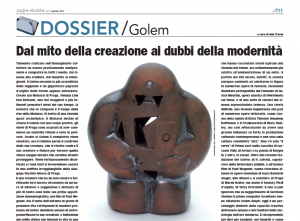MEDIA The Golem, from Myth to Modern Icon
 The January issue of Pagine Ebraiche features a special section about the figure of the Golem, edited by journalist Ada Treves. The following is the introduction to the special section.
The January issue of Pagine Ebraiche features a special section about the figure of the Golem, edited by journalist Ada Treves. The following is the introduction to the special section.
By Ada Treves
So rooted in collective phantasy as to be virtually omnipresent, the Golem has a role in all media, from film to sculpture, from comics to video games. According to the most widespread legend it is a giant clay model of a human figure with a vague shape. Created by the Maharal of Prague, rav Yehuda Löw ben Betsalel, one of the most influential Jewish thinkers of his time, it is made with mud coming from the banks of the Vltava. The story is almost archetypal: the Maharal decides to create the Golem with a specific purpose because Jews in Prague are in danger, accused of ritual murder. Thanks to the Golem the plot is foiled, but the rabbi loses control on his creature who turns against its creator and ends up pouring that same Jewish blood that it was supposed to protect. It is fortuitously “turned off” and its remains are still hidden in an unattainable attic of the Old-New Synagogue in Prague.
The Golem is a creature that has a dark and terrifying side and is still surrounded by an aura of mystery and awe now, more than a hundred years from its first appearance in the film by Paul Wegener. However, the theme of the automaton that can come to life corresponds in a profound way to the ancient human desire to anthropomorphize his creations, in imitation of the divine breath that gives life to a form of mud and clay, like the Golem. Moreover there is the perturbing idea of a creature that betrays its own nature and the magical power of words and letters, so strongly linked to the tradition and culture of the Jewish minority. “Emet,” truth, is the word that brings the Golem to life, and to stop it forever the only thing to do is to delete the first letter, so that the scroll reads “met”, dead.
The story is actually much more remote than the story of the Maharal of Prague: the term already appears in Psalm 139,16 where it indicates a “shapeless embryo”. According to Talmudic tradition, these are the words of Adam to God, and are to indicate a human body that is still without a soul, and many great scholars during the centuries have devoted time and efforts to building a Golem.
Instructions on how to proceed to its creation multiply in the twelfth century, before Paracelsus’s experiments to give life to his Homunculus, and Moshe Idel documents that the creation of the first “modern” Golem is by Elijhau, rabbi of Chelm, before the one by the Maharal, but the mysterious fascination of Prague, so well understood by all nineteenth-century authors who have told stories inspired by the Golem was obviously more suited to the setting of a myth. Since the nineteenth century, in fact, European society began to adopt the figure in numerous works of fantasy, making it the protagonist of Gustav Meyrink novel, the classic reference work of reference on the subject, and of German expressionist films. A truly difficult story, disturbing as many literary works as The Sandman by Ernst Theodor Amadeus Hoffmann or Mary Shelley’s Frankenstein, so fascinating to have an influence on the whole contemporary cultural production.
Not only “Il servo” by Primo Levi (in the collection of short stories titled Vizio di forma) or the poetry by Borges in The other, the same: in addition to the recent translation of Golem by H. Leivick, a masterpiece of Yiddish literature, and the iconic Paul Wegener film, there are the works by Isaac Bashevis Singer, Elie Wiesel and Marek Halter’s The Kabbalist of Prague, but also Feet of Clay, by Terry Pratchett. And it has to be remembered that as Gershom Scholem suggested the first Israeli computer was named Golem Aleph.
Today the Golem is a symbol of human creativity and of modern technology’s advancements. Its incredible success in children’s books, comics, or as a character of so many games and video games, is made even more evident by the extraordinary exhibition curated by Emily Bilski and Martina Lüdicke for the Jewish Museum in Berlin, and it should not be forgotten that the Golem is a creature searching for its own identity and fighting for that autonomy that it is not even sure is desirable. And it imposes to all of us to question ourselves about the right to use violence in extreme situations.
